BTECH GMRS-Pro

Yes, you can use the BTECH GMRS-Pro on your motorcycle’s Bluetooth communicator!
Or pretty much any Bluetooth headset for that matter.
The Difficulties of Cross-Species Communication
I ride motorcycles (specifically a dual sport in regards to two-way radios), off-road in my Jeep with groups, go hunting, hiking and kayak fishing. The problem with trying to communicate with others in those types of activities, especially between motorcycles and 4×4’s (hereafter “vehicles” or “cages”) is that the equipment and mode-of-use differ dramatically. The focus here is between motorcycles and vehicles as the solution for those overlaps with the solutions for the rest.
Motorcycles use Bluetooth (BT) communicators attached to their helmets with speakers and microphones attached to the interior. These communicators connect with phones and, depending on a bunch of factors can do mesh BT connections between other riders. The proprietary nature of these devices is more than a little frustrating. My brother had brand X, I had brand Y and according to the technology we should have been able to just talk to each other while riding across the US. Nope, brand X can only talk with other brand X and vice versa, so the only way we could talk was by cell phone. The fact that we were doing an off-road trip meant that we often didn’t have cell signal so my brother and I rarely talked while on the bikes. Thanks manufacturers, you all suck. Get over yourselves and fix that.
Technically bikes can talk to bikes but bikes can’t talk to cages. No one in vehicles, even if they’re wearing BT helmets in their side-by-side can readily communicate with bikes. And while yes, bikes and cages don’t make good bedfellows, sometimes they do need to be able to communicate and at a reasonable distance.
Solving the Problem:
I’m going to give you my solution first followed by a long winded explanation as to how I came to that conclusion: Bluetooth FRS/GMRS (“walkie talkie”, “radio”) with a Push-to-Talk (PTT) and various BT headsets. Here’s the short version on how to do it and as of this writing it’ll cost you less than $200, not including your headset or any mounting gear:

2. BTECH GMRS-Pro K1 adapter cable
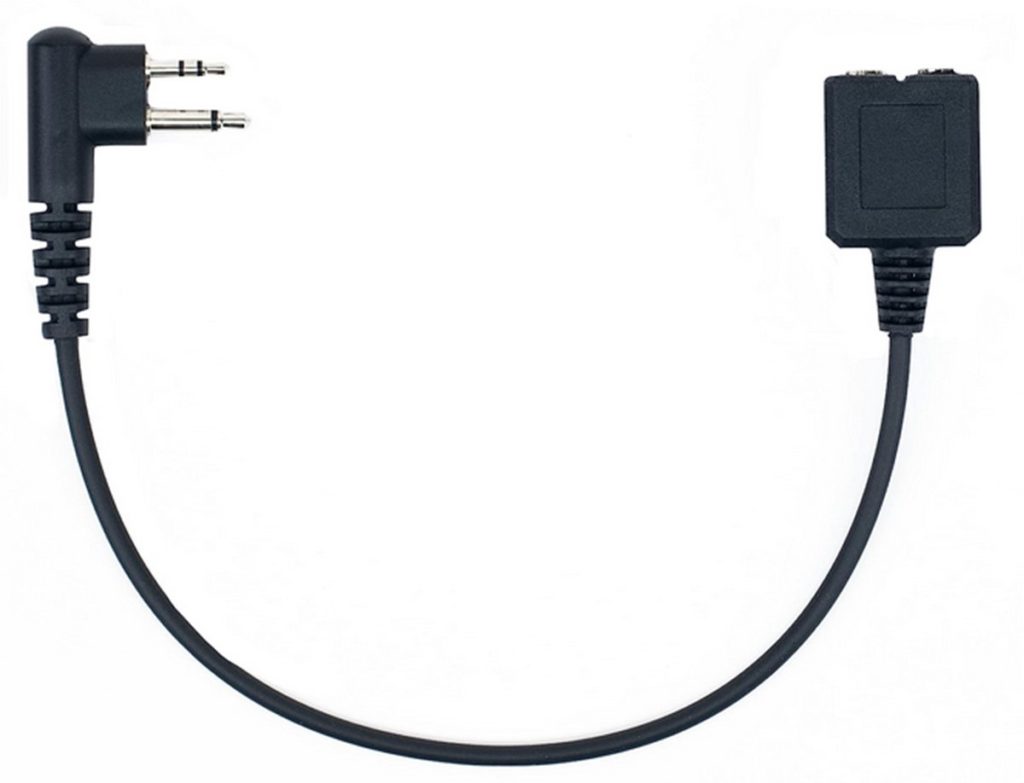
3. BTECH K1 Stereo adapter with PTT. You probably do NOT have to use the BTECH brand, I did because I knew it would work, had a Velcro style PTT which I could mount to my bike, and if needed, a stereo connector if I needed to hardwire to an earpiece.
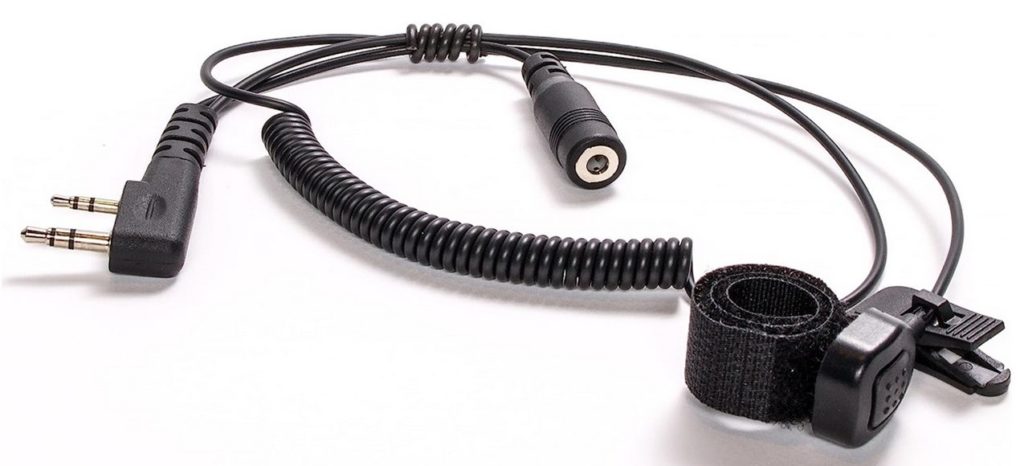
- Bluetooth headset of your choice. I’ve used two different (and both discontinued) BT phone headsets and my Uclear HBC100 motorcycle headset, the latter being the impetus for this whole project. They all work just fine.
That’s really it. There are currently precious few BT radios on the market with the BTECH GMRS-Pro being pretty much the only game in town with the right combination of reasonable features and price. More on that later.
How I came to this decision:
** DISCLAIMER**
This will be a rather long essay and will be from a radio newbie’s perspective which, while overall accurate for the nature of the problem, will have some generalities and laymen’s terms for the concepts which radio nerds will readily pick apart. If that’s you, feel free to politely comment because a little edification never hurt no one and I’m working on a steep learning curve here.
Also, this is also only relevant to the USA as laws may be different elsewhere.
How to talk:
Note that in the end it really comes down to radio frequency and power. Your cell phone is technically a radio. You’ll see frequencies listed such as 26.965-27.405MHz such as for CB’s with channels separated by 10MHz jumps and 462MHz-467Mhz for FRS/GMRS but with different assigned jumps for channels. FRS is extremely limited on power and antenna size whereas Ham radios can go nuts on both, but there are laws and licensing required to play with the big dogs. Think of the power like your local radio station (not streaming). Every now and then, especially on AM radio you’ll hear an announcement about being 50,000 watts. What you’ll note personally is that you’ll hear that radio station a few hundred miles away but the local, lower powered college station disappears in 50 miles. The concept is the same for these radios but on a much smaller scale.
In the long-range vehicle communication world you have the following options:
CB (Citizens Band)
FRS (Family Radio Service) walkie talkie two-way
GMRS (General Mobile Radio Service) walkie talkie two-way
Ham (Amateur. Various explanations for what it stands for but not an obvious acronym like the rest)
VHF (Very High Frequency, Marine Band)
UHF (Ultra High Frequency) (I’ve heard this is actually GMRS?)
MURS (Multi-Use Radio Service)
I’m going to dismiss VHF, UHF and MURS right out of the gate. VHF because I’m fairly certain those are only for nautical communication and UFH/MURS because I’m not very familiar with them and I don’t know many people explicitly using them. I believe MURS was probably used primarily for businesses at one point and I’m ignoring major events and races as those involve special permits or business networks beyond the scope of my knowledge or use.
I’m also not including cell phones, satellite communication or internet as those have distinct limitations in reception, costs, and off-grid reliability. They have their place and on a road trip you can even download walkie-talkie apps to good effect, but 2-way radios as noted here are far more reliable in the wilderness.
I’ll also note that pretty much any of the technologies can be used for communication purposes, the caveat being cost of equipment, cost of licensing, and significantly, if anyone you know is using it. If everyone is on Ham but you’re on UHF, you’re not talking (probably, because there can be downward/reverse overlap but it’s usually one way, so one is listening and one is talking and listening. A GMRS can talk to FRS but an FRS may not be able to talk to a GMRS).
CB:
Citizens Band radios are the original vehicle radios going back almost 100 years. Watch any movie with truckers in it from the 90’s on back and that’s what you’ll see. Go watch Smokey and the Bandit, great film. For those of a certain age, seeing a the coiled cable of a CB speaker hanging from the roof of a truck was something special. CB’s were and still are great, they’ve just been overtaken by other technologies more suited for the general purpose. Cell phones, in-vehicle internet and online updates for traffic and weather have negated the need to set-up the relatively complex CB system.
You need to buy a radio, speaker/mic, and antenna and then spend an inordinate time learning that you have no clue how to tune the massive flag-pole of an antenna you had to mount on your bumper. Still a viable technology, just not the default for the off-road world anymore.
FRS:
Go to a retailer, buy a $30 set of Midland T10 2-ways, some batteries and go on your way. These are the cheap radios you give to kids or for casual groups of people. Not that they don’t work, they work very well, they’re just very limited on range and power (2 watts) which generally means line-of-site communications less than a few miles. Completely ignore the claims of dozens of miles, that’s patently false. On a crisp, clear day with perfect line-of-sight and perfect atmospheric conditions yeah, you can get 20+ miles even on a cheapo unit but no, you really won’t. When your buddy gets 3 cars ahead of you you’ll start losing signal and quality. Cut a loud fart and you’ll only get 2 cars ahead.
You can buy $100+ units with some fancy features, but in terms of the radio, they’re legally limited to low power and a fixed, small antenna. Yes, Baofeng tends to flaunt that rule but they’re skirting the law. I have four of the T10s because they work fine, use rechargeable AAA batteries, and that time someone dropped it in a mud puddle and it didn’t work for the rest of the day didn’t make me cry. Many/most of these have stupid proprietary and large basket chargers. Horrible design, hate it.

GMRS:
Essentially a better FRS. More channels, more available power (5 watts for handheld, something like 40 watts for base units), potentially removable antennas for better reception. Generally you’ll see these as FRS/GMRS. Legally these require a license to operate and while few people actually do that, I did. It’s something like $35 now and doesn’t require any training or education, it’s just a operator’s fee. You have to jump through a few hoops and it’s not straightforward, but it is cheap and easy.
I believe they made some changes to the available frequencies between FRS and GMRS but overall it’s not important. If you have a GMRS license you don’t have to care.
There are things called “privacy codes” on these which is a slight misnomer. What it really means is a sub-channel which will likely have fewer users. Like network TV, what used to be channel 11 is now 11.1, 11.2 & 11.3, with the decimals being akin to privacy channels. Some radios will call it by a privacy number, others such as the BTECH note the actual frequency but it’s the same thing, just more accurate and confusing. Generally if your group is using a privacy code it’ll just be your group talking, but know that anyone else on that same code can year you, so it’s not private per se just quieter and probably more private.
This seems to be the direction most people in the off-road world are moving which makes sense – see why in the ham section below.
Ham:
These radios wear the big-boy pants. With the right set-up power users can bounce off the atmosphere and talk to people literally on the other side of the world. When the dragons from Reign of Fire finally start to die out, it’ll be ham operators who are asking for French wine from their neighbors. I do not generally recommend these for vehicle-to-vehicle purposes though, for reasons I’ll note below.
In the way back times Ham was generally relegated to in-house base units or very expensive mobile units but, at least as far as I’ve seen a Chinese company called Baofeng came on the market with cheap, handheld units and it took the off-road world by storm. This was the direction that everyone was moving, many still are. However, pretty much no one knew what radio band they were talking on, they just knew the radios were great quality for the relatively cheap price and put them to use. Queue every pissed off ham operator…
They’re mad because once you jump to ham you’re jumping into power levels which can potentially interfere with government communication, wifi, etc. The requirements to use ham aren’t fees, they’re literally pass/fail in-person (or watched closely online live) classes which cost about $85 at a minimum for a technician’s license (base entry license). During the Covid closures the requirement to get a ham required that I have two cameras watching me, one front, one side, and I believe only one screen turned on with no cell phone active. Typically the cell phone is expected to be used as one of the cameras. They’d then have no less than two people watching during the entire exam.
But even once you pass it’s technically not that simple. While a GMRS license can cover an entire “immediate” family, it doesn’t cover friends so technically they’d have to have a license to respond. Does anyone care? Yes. Will anything happen? Only in rare circumstances.
Ham is different. Every operator has to have an individual license. This means if I have a ham license and you don’t, I can talk to you all day long and you can listen completely legally but you can’t respond or you’re breaking the law. Will anything happen? Well… Quite possibly if improbably. Ham operators take their craft very seriously, will take umbrage at your flaunting of the laws and have no problem turning you in to the authorities.
So can you illegally use a ham radio with your group even though few people, if any, are licensed? Sure. You can also sleep while your Tesla’s auto-not-autopilot drives you home but you shouldn’t and there can be consequences. That said, it’s not terribly uncommon to carry multiple radios and even put the two hams first and last, so they can communicate with their higher power set-up, while the overall group uses GMRS or whatnot. None of this is ideal but it’s workable.
SO MUCH INFORMATION!
I haven’t even scratched the surface and Dorothy, it is a rabbit hole of confusing proportions, one into which I’ve only dipped my toe. I haven’t even mentioned things like squelch, IP ratings, the hundreds of custom(!) channels, repeaters, custom channels, NOAA weather or how much would a woodchuck can chuck!
In short:
FRS is a great gateway drug and can generally talk to GMRS radios since GMRS includes FRS frequencies. The cheaper models such as Midland T10 Xtalkers are FRS only but FRS/GMRS is extremely common and affordable. Get an FRS/GMRS and once you get the license feel free to use every available frequency.
Ham is a great option if everyone in your group is licensed. Gives you the most power and range options and most upgradability but you’re always limited by the license requirement. Technically Ham can talk to FRS/GMRS but in practice and legally they cannot.
Get to the GMRS-Pro Already!
Having decided that GMRS was the correct direction, I went back to the issue of motorcycle to vehicle communication which meant finding a Bluetooth connection. There are technically BT adapters which can act as a middleman between devices but they were too bulky, wonky, or otherwise expensive and not ideal, so an integrated unit was the goal.
At the time I purchased the GMRS-Pro there were essentially three options: The Motorola T800 Talkabouts, the Garmin Rhino series and of course, the GMRS-Pro. The Rhinos with BT have a large range of costs with the cheapest being the 750, followed by the 750T, and finally the755t, have overlapping features to other equipment I already own and frankly has GMRS as a secondary feature rather than just being a radio. The T800 might work but has too many limitations for my purposes, not the least of which is missing a K1 connector.
A K1 connector is the abbreviation of a Kenwood two pin connector, essentially two stereo plugs of different sizes. It’s pretty much the universal standard for adding accessories (with a mini K1 called an M1 as an alternative, more on that later). Note that cheaper radios will not have a K1 or similar connector, at most a regular stereo plug but often not even that.
So… This pretty much leaves the BTECH.
Without further ado, the BTECH GMRS-Pro:
BTECH stands for Baofeng Tech which basically means they’re Baofeng radios. They’re not the same company, I think BTECH is an importer and modifier or whatnot.
Features I use or care about (has many more which are beyond my knowledge or need):
Bluetooth:
Speaks for itself. It’s integrated and important. I have three Bluetooth headsets, a BT portable speaker, three BT headphones, a dedicated motorcycle helmet BT system and heck, even the keyboard I’m typing this on is connecting to my computer via Bluetooth. It’s not a new technology, the two-way industry is lagging it.
Cell phone app:
Not technically required, incredibly useful. Communicates via BT (see what I did there?). All settings can be done on the device itself but it’s lacking the keypad found on basically every other device, so you’re scrolling and clicking to navigate rather than simply typing in numbers. Extremely quick and reliable for me on the app, haven’t mastered the unit itself yet. The good news is that these settings are usually one-and done, after your initial set-up. Typical scene is asking which codes the group is using, setting them, and then just turning the radio on and off.
But speaking of set-up, there are myriad options to the power user, you might even be able to use CHIRP. Don’t know what that is? If you’re learning how radios work from this article you don’t need to know. It’s an open-source programming tool if you’re into that type of thing.
IP67 waterproofing:
IP stands for Ingress Protection and the two numbers represent solid object (dust) and liquid resistance respectively. If you see only one number you’ll hopefully see an X next to it, which just means that either the dust or liquid doesn’t need to be rated. The higher number the better, with 6 being the highest rating for dirt and 9 being the highest for water, although 7-8 are the most common. Since this radio isn’t designed for swimming laps or being attached to the hull of a boat a 7 is good enough. I saw a review once where a guy tested various radios, including the BTECH by dumping them in a 5 gallon bucket of water and coming back something like 30+ minutes later and then testing their quality. The only complaint on the GMRS-Pro was that the audio quality wasn’t perfect, but it’s already a tad muted by being waterproof, so no biggie. Worked fine. So yeah, this is tough enough.
USB-C CHARGING!
Seriously, the radio companies make those stupid platform chargers which, while kinda okay for a work environment where you just slap it in the hole and go home, are incredibly annoying and are virtually impossible to use in a vehicle, let a lone a motorcycle. USB-C is magical in comparison. But wait, it gets so much better I’m getting giddy over here. The USB-C isn’t attached to the radio, it’s part of the BATTERY!!! Yes, the battery. This means you can buy a 2nd battery if that’s your thing and just plug it into one of the dozen cables in your car already, set it in the corner somewhere and ignore it. Can you imagine if your Go-Pro had a special insecure plastic base to recharge rather than just having a USB-C (or micro-usb if older, no hate) case in which you can juice up multiple batteries? This is a deal-breaker for me on almost any device.


Very limited SMS Messaging:
This is a gimmick you’re seeing on higher end radios, interestingly including the T800 and Garmin. However, it’s extremely limited because it’s piggybacking on the GMRS frequencies, not terribly reliable, and proprietary to each brand. Not sure if that’s a technology limitation or just more arrogance like Apple and their insane chargers (and yes, they even artificially limited the Europe mandated USB-C to charging and basic data only. Still have to use a proprietary lightning cable because more money for them). Thus, if you have an expensive GRMS device which is equal in power and distance to a cheap GMRS device, and I too have said expensive GMRS device we can unreliably send limited text messages. Jokes aside, this is something which will likely become a standard feature on ever more devices and to the betterment of the users.
GPS/Compass:
Yup, this actually has GPS mapping on it and a digital compass. Should show tracks on the map with other info like the coordinates, elevation, etc. I think you can even share your GPS location to others, but like the texts only within GMRS range. It’s not a GPS communicator or emergency beacon, although I can see a future where that could be a thing. Still, handy. Probably worth mentioning here that this has a color screen, but that doesn’t affect power much. Probably because the battery is so chonky. Note that you can also use the phone app to get a larger GPS fix, maybe even navigate for all I know. Haven’t had a chance or need to delve into this much as I have my phone, GPS watch, and full Garmin GPS so it’s redundant to say the least.
K1 plugs:
This is where this radio falters, although it’s easy to get around for about $25. It uses what looks like a mini-K1 jack called an M1, so to get it to work you have to buy a $5 cable for $25 but it does work. Given how good everything else was on this I chose not to care, but it’s annoying and I don’t know why they went that route.
Another demerit on this is that to use the plug you have to unscrew an easy-to-lose plastic cover with an even easier-to-lose screw. I just put the screw back into the hole without the cover for safekeeping. I’ll probably never put the cover back on as I’ll almost always be using some sort of attachment. Would rather have just had one of those rubber pop-out covers unless that negates the IP rating in which case it’s okay.
Kinda sorta removable antenna:
This one is rather funny and while I haven’t done it myself I’m told the antenna – which legally has to be “permanent” for licensing purposes seems to be a fully removable unit which per the manufacturer is “permanently glued in place”. Removing it voids the warranty but going back to the Midland T10, there’s not even a possibility because that antenna is literally part of the unit, molded in place. Try removing your cell phone antenna, same thing. So yeah, I think they just cheated and glued on a removable antenna and called it permanent. What I don’t know is if you can legally upgrade the antenna or if it’s really worth it on a portable unit. Yet more holes for the rabbit.
If you’re curious, here’s the law: https://www.ecfr.gov/current/title-47/chapter-I/subchapter-D/part-95/subpart-E/section-95.1787
Other Stuff:
It has an FM radio, NOAA, adjustable squelch, unlimited repeater support, etc. What it notably doesn’t have is a light because that’s apparently a key feature on many radios. I like lights on everything, my watch even has a light, but again, not a deal-breaker.
Oddities and confusion:
Privacy codes:
Pick up a regular walkie talkie and you’ll get something like channel 18 privacy code 2. The GMRS-Pro has that, only it notes the Rx CTCSS/DCS and Tx CTCSS/DCS frequencies. Then you get a drop down next to each with numbers like 91.5 & 94.8 and you’ll be completely flummoxed as everyone simply sets their own radio to code 2 and drives off. You’ll end up bookmarking a website for future reference. In this example, CTCSS (“privacy”) code 2 equates to a frequency of 94.8. Having no clue about Rx vs Tx I just set them both to 94.8 and it seems to work. When you’re on your phone setting this up because you got lost trying to do it on the device you’ll see a bunch of other options which you should probably initially ignore. When – not if – you get confused, go to NotaRubicon and get your fill of info and dry humour. Don’t know the bloke, I actually do drive a Rubicon so I don’t know if we’d get along…
Conversation recording:
There is a setting somewhere which I utterly cannot find at this time which actually records your conversations for playback. I figured this out by happenstance and was able to disable it. I’m not sure if it was enabled by default or if I did it accidentally when playing around with the settings. Cool feature to have, not sure if I have any use for it.
Belt clip installation:
The belt clip installs on the battery using two tiny little screws while the clip is under spring tension. Done wrong and you’ll soon be missing two tiny little screws. Take the battery out, install the clip without tension, install the battery. Easy peasy.
Wired stereo plug headphones using the PTT splitter:
Every wired set of earbuds I used worked but some only worked in one speaker, not sure why. More of a curiosity than a concern.
Motorcycle Mount:
I’m going to do a separate review on this and link it back here, but this radio doesn’t fit the standard Baofeng/Rugged Radio cases, it’s just too big. If I used the belt-clip slide on style it would work fine but that’s unsafe on a motorcycle so not an option. I was able to get the Bulletpoint Radio Holder to work with not too much effort, but it did involve a bit of grinding, custom fabrication and plasti-dip.
Bluetooth audio quality:
Your mileage will vary. On both of my Motorola headsets and my motorcycle unit I get a small delay when people are talking to me or when I push the PTT. However, there are myriad factors which can cause this as well as ways to get around it. People speak too soon, too fast, or put the radio almost inside their mouth. If the other person is reasonably deliberate I hear everything just fine. In terms of the PTT there seems to be a slight delay but I just wait a half-second after depressing to start talking but that’s a decent habit to learn regardless. I can say that in a 2hr freeway drive between two vehicles I was able to use my headset and the PTT with zero issues. Much more convenient than fumbling for the radio every time.
Below is a picture from that trip where I was driving a buddy’s vehicle. You can see the radio clipped to his CB mount and the PTT on the phone holder. All I had to do was push that button to talk, nice and easy. No clipping the radio to my seat belt or roll cage, or putting the radio on the dash or cup holders. Also no cables to get in the way of shifting because real 4×4’s have stick shifts!
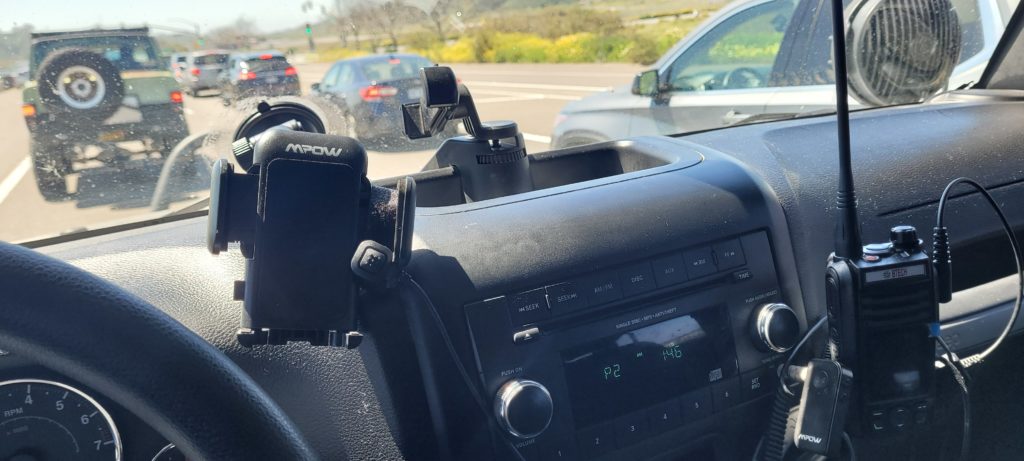
Specific to the bike many factors can come into play. My dual-sport helmet combined with not having a windscreen means anything over 25mph is difficult to hear, but that’s to be expected. However, I was able to hear my friend just fine at almost all speeds and respond with hand-signals as needed. I’m sure if I had a higher quality and newer system combined with a windscreen it would work better. But I’m not overly concerned about talking in those conditions or especially off-road. If someone contacts me on the radio I can always just pull of the trail and get back to them.
Here you can see where I mounted the PTT to a mirror post and have the K1 connector coming out on the right. We’ll see how water/weather resistant it is over time. There are wireless BT PTT and more ruggedized versions but this met my needs for the R&D for an affordable price. Can always upgrade later but I’m talking now.
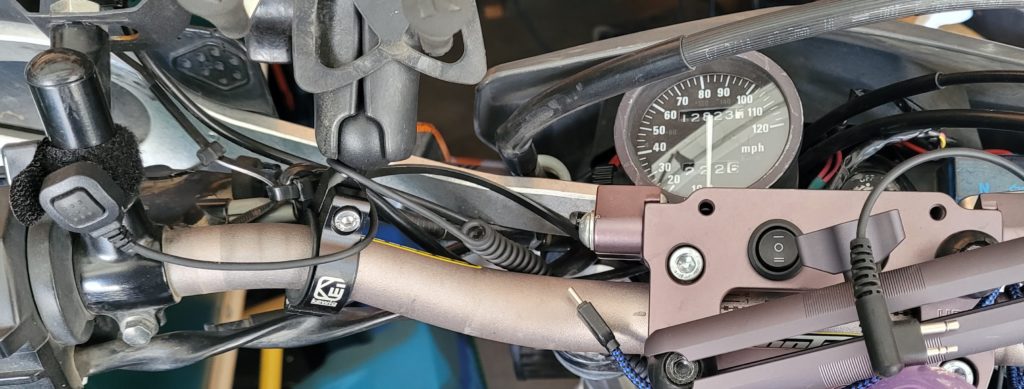
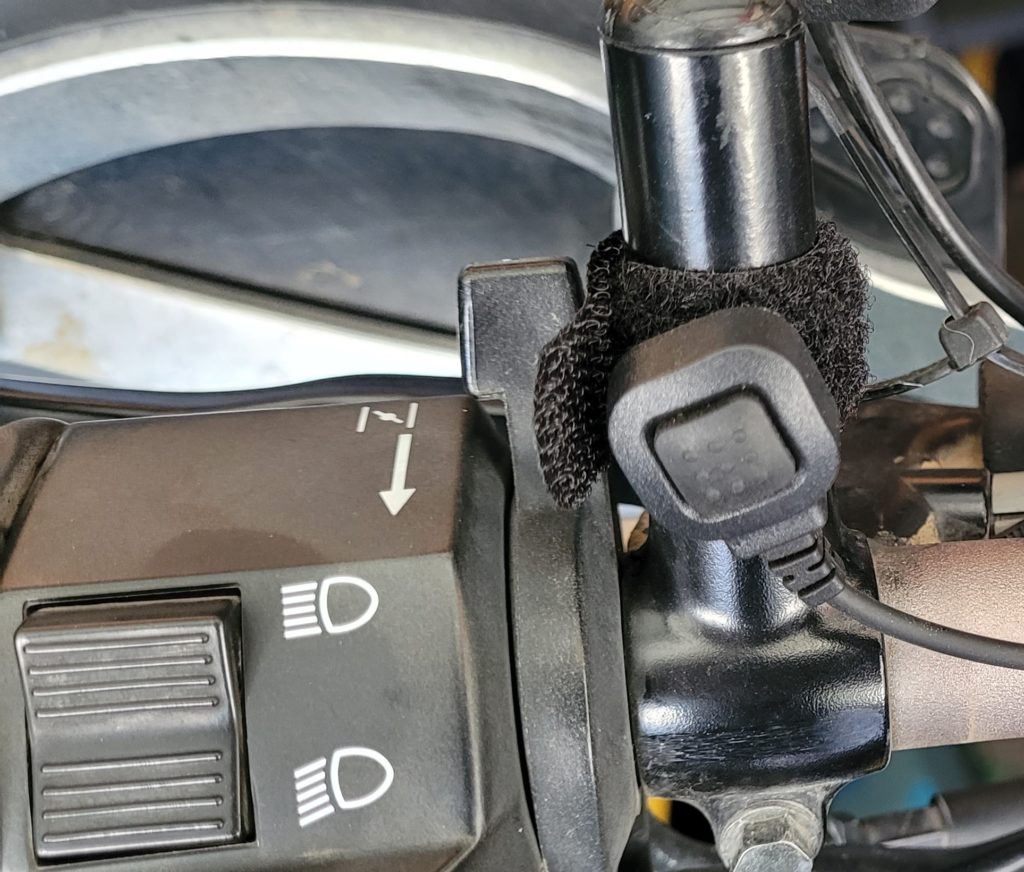
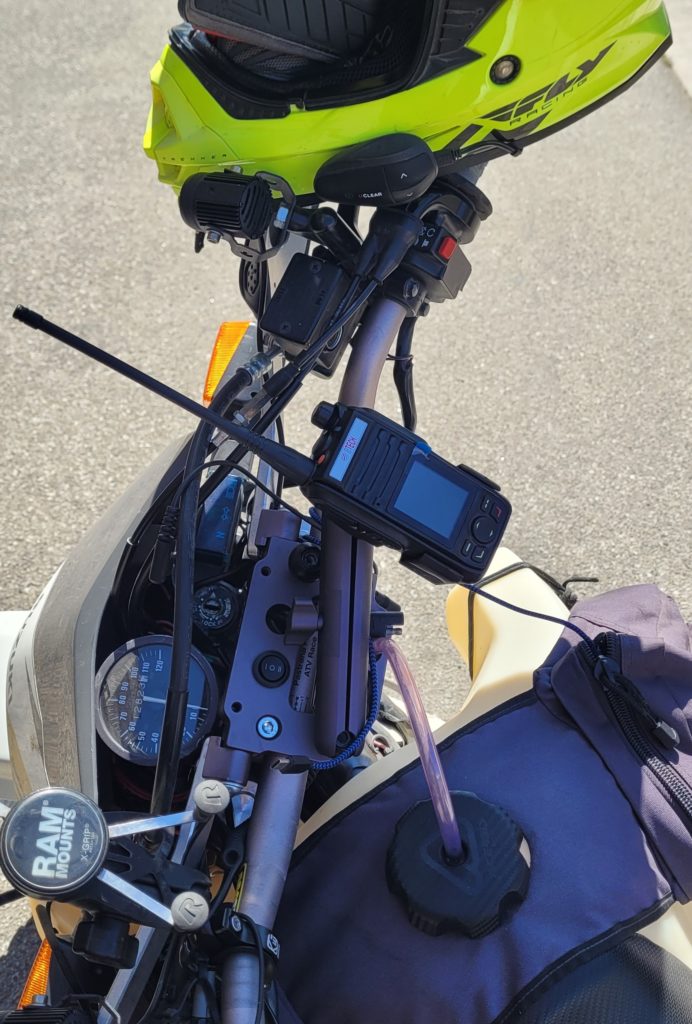
Which brings me full circle back to the start of this essay. By using a good and generally universal FRS/GMRS unit with BT I can now talk bike-to-bike, bike-to-vehicle or vehicle-to-vehicle. If I chose to use VOX I could probably use a BT headset and keep my hands free while spotting other drivers up difficult sections. If I slip, I don’t toss the radio down the hill because it’s securely on my hip.
For hunting I can attach the radio to my pack, attach the PTT to a strap and keep the BT in my ear. This will allow me to communicate to my party but not spook any wildlife. Same thing would apply to any group in the wilderness needing to communicate at a distance either discretely or with only one hand (or none if using VOX).
While I haven’t tried it yet, I could also take it kayak fishing. Attach the radio somewhere as out of the way, put the PTT on the life vest, and again with the BT in the ear. Can’t see this being a really big use but two situations come to mind: I’m in the lake fishing and the campsite is trying to call me or I’m doing a meetup kayaking group and need to stay in communication with the lead while I’m the sweeper.
This radio is a game-changer and while currently expensive and uncommon I fully expect that to change. This is the early-adopter version and the ability to cross pollinate motorcycles with cages is a huge relief to me. 100% recommend if this is your need. If not, save $100 and go with innumerable other options. But this really should be your thing, it’s awesome.






Comments are closed here.